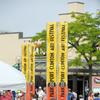Who's Data is it?
- October 08, 2013 12:14
As we watch the social network Twitter.com playing an important role in a revolution, we can begin to appreciate how much we have underestimated the power of the Internet. You certainly have heard how various banks, credit card companies, government agencies etc., etc. have cataloged and stored your information to do who-knows-what down line. Do we really know or rather can we really know the impact of our decision to give up data? In some cases you can't control it, so just go with the flow. In my mind there are two critical questions: What are you going to do with my data, and who has access?
In the field of tribal art some obviously bright guys have figured out the importance of cataloging your data, which is primarily comprised of photographic and descriptive information of your collections. The most important man in this effort is undoubtedly Guy Van Rijn, who is now the archivist of the Yale Art Gallery-van Rijn Archive of African Art. "The Yale Art Gallery-van Rijn Archive of African Art is a collaborative project based in Brussels. Currently, a copy resides at the Yale University Art Gallery. Yale University has plans for a future on-line version, when and how it will be accessible is, due to legal issues such as copyrights, not yet known”. The Yale website describes the database in the following manner: "The Yale-Van Rijn Photographic Archive is the largest photographic digital database of African art, and is a division of the Department of African Art, established in 2004, at the Yale University Art Gallery. The Archive has been under development by Guy van Rijn, for several decades. In 2001, the project was acquired and funded for Yale by James J. Ross (Yale B.A. 1960). The ultimate goal is to make the Archive accessible online, but at present it is available for general research by appointment only at the Department of African Art at Yale, New Haven, Connecticut, USA, or at the Van Rijn Documentation Centre, Brussels, Belgium.
The Yale-van Rijn Photographic Archive comprises images of art from Africa south of the Sahara in collections worldwide. As such it is potentially infinite, but at the moment it includes mainly masks and sculpture and a few other forms in various media, from antiquity to the mid-20th-century and it will continue to grow as the archivist receives new images. Currently there are more than 100,000 images of African art drawn from private and museum collections, dealers, general archives, and the existing body of literature including books, articles, notices, and auction catalogues. The database may be searched by country, cultural group and many other fields, enabling the user to do a specific search. The Yale-GVR Archive may be used for research purposes only. In making these images and their related documentation available to researchers, YUAG’s Department of African Art provides an unparalleled resource for the study of African arts.
The Archivist solicits images from collectors of photographs and/or objects who would like to include their collections in the Archive. It should be noted that Yale makes no claims to authenticity of the objects illustrated (by any definition of the term, authentic), and the inclusion or exclusion of an image for any reason is at the sole discretion of Yale.
The Archive will also include opinions (including those concerning authenticity) in the Archive database submitted by third parties, at Yale's discretion. Yale takes no responsibility for these opinions, and in no way do they reflect an official position of Yale. We expect that this will provide a forum that will be useful to all researchers. In this working phase, we would ask visiting researchers who are using the Archive to exchange their own images and expertise from their fields of study in order to enlarge and refine the Archive and database for future users." In addition Van Rijn has also compiled the database, "Who's Who in African Art".
Van Rijn is now a principal of and the archivist for Danster Research Center, which is described in the following manner:
"About us Danster Research is a newly established independent non-profit institute directed towards the research of traditional Arts and Crafts of Africa. Its aim is to foster and boost research as an independent institute and to provide support as well as infrastructure to those whose research is deemed to be invaluable to create a more comprehensive picture of the Arts and Crafts of Africa. We at Danster feel that such an independent research institute could fill in some of the lacunae and help the more institutionalized research institutes to complement their findings.
As we all know there always has been a bit of an uneasy relationship between the scholarly and the more mundane world of those commercially active in African Arts. Our independent position, however, allows us to support research in those fields we feel are somewhat neglected but where knowledge can be harvested, crucial to a better understanding of the African Arts and Crafts. Danster Research feels that there is a void to fill. Although research will be carried out on a completely independent base, Danster feels that cooperation with existing institutionalized research facilities is necessary and even indispensable if one wishes to grasp a broad and in depth comprehension of the Arts and Crafts of Africa.
Danster Research feels that there are multiple ways to foster different kinds of research projects, benefiting scholars of different disciplines e.g. ethnographers, anthropologists and scholars from the sculpture of Africa. Financing and supporting projects will take up a large part of the funding but forgotten areas of research that need attention can and will also be focused upon and even coordinated and instigated by Danster Research e.g. collection of private documents, photographs; the acquisition of files and in general mapping out areas that deserve extra attention."
Pretty impressive by any standards and what a resource of information! Once you recover from the immediate flights of fantasy about what a difference this sort of data might make in your life as a curator, appraiser, dealer, or collector, the question always come down to who has access to the data and what do they do with it. One would think that this question is pretty straightforward and easy to answer. But it is not. Let's first dispense with Who's Who in African Art. That one is easy… you pay 80 euros and you get a copy.
The primary complication with the Yale Archive and Danster Research is that you have a mixture of non-profit and for profit intertwined in both projects. Do commercial entities pay thousands of euros to sponsor projects that they can't access until various copyright issues are resolved? Are some very high-end dealers participating because they are being told where all the masterpieces are now located? Can pieces that might otherwise not meet institutional provenance requirements be vetted by dealers by false data provided in the databases? Are some people being blocked from access to data while others are given access? Data providers are guaranteed to have their privacy respected. How is that done? Are there layers of access? Why is there one copy of the Yale Archive in New Haven and one in Brussels? Are there different access protocols for both? I don't know the answers to any of these questions. I do know that several of the folks are involved in all three projects. The only one of the principals that I do know is Jim Ross, whom I respect as both a collector and as someone who has had the vision and resources to fund something as important as the Yale archive.
I hope to have some interviews in the coming months with the principals to answer some of these questions. Now and in the future, data is a very valuable commodity that must respected and secured.



















